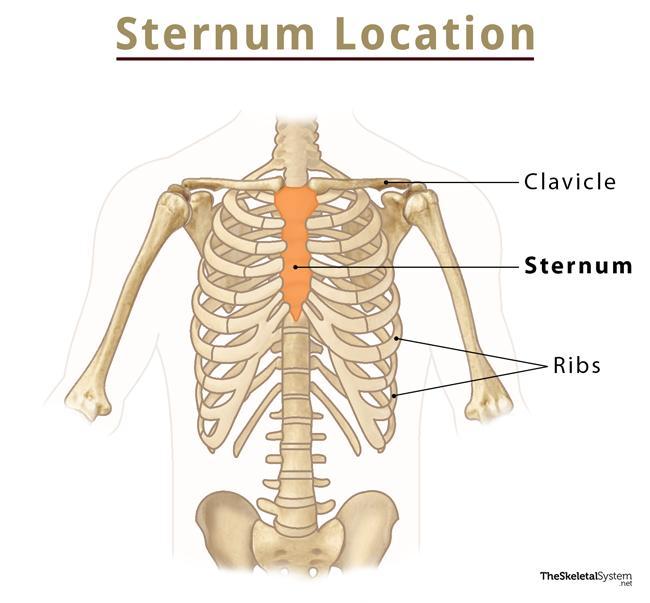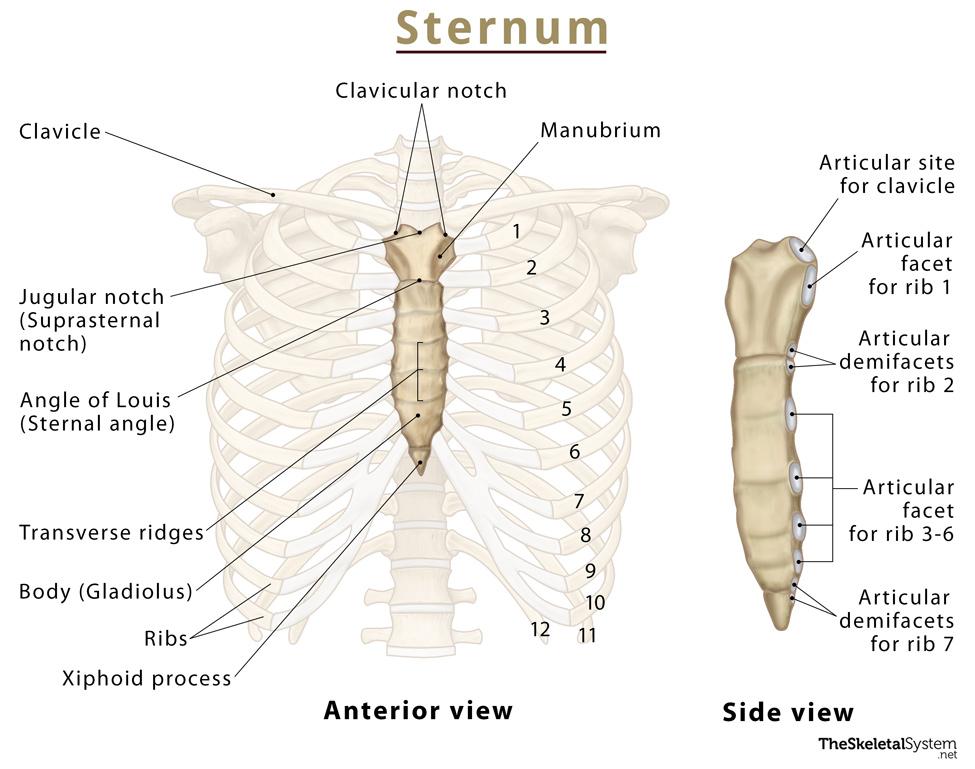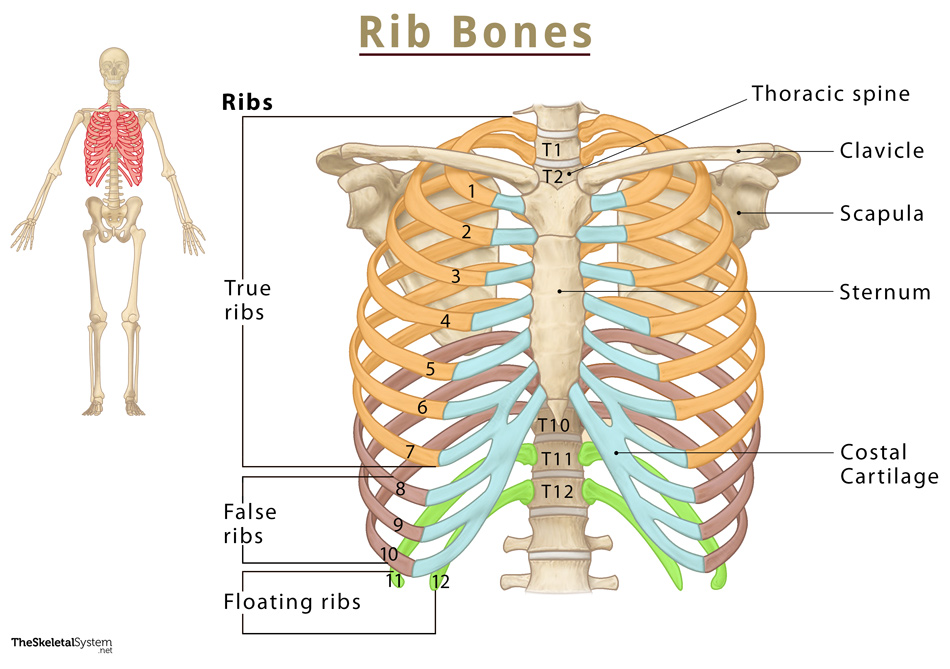Sternum (Breastbone)
Table of Contents:
Published on December 29th 2021 by staff
What is the Sternum
Sternum, commonly called breastbone, is a long, flat bone located in the midline of the chest. The word ‘sternum’ has been derived from the ancient Greek word ‘sternon’, meaning ‘chest’. The bone covers and protects the thoracic organs, such as the heart and lungs, from any external shock.
Where is the Sternum Bone Located

The bone is located in the center of the chest, making up the anterior thoracic wall. As it lies superficially, it is easily palpable below the skin of the chest in the midline.
Quick Facts
| Type | Flat bone |
| Length and Width | Approximately 6 inches, and 1 inch |
| How many are there in the human body | 1 |
| Articulates with | Clavicle, and the first seven pairs of ribs |
Functions
- Protects the delicate organs of the thorax region, such as the heart, lungs, esophagus, and several important blood vessels, from mechanical damage.
- Helps in the expansion and contraction of the thoracic cavity during respiration.
Parts and Anatomy
As stated, the sternum is a long, flat bone divided into three parts. Its shape can be compared to an upside-down sword. Its top rectangular part, (i) the manubrium, resembles the handle, whereas the flat, long middle portion or (ii) body looks like the sword’s blade. The pointy end of the bone, (iii) the xiphoid process, appears like the sword tip.

Manubrium
It is large and quadrangular or trapezoid in shape, bearing several important bony landmarks.
Structure and Bony Landmarks
The top part or superior border of the manubrium is concave, producing a depression called the jugular notch or suprasternal notch. On either side of the jugular notch, two other large fossae, known as clavicular notches, are present, projected upward and laterally. These fossae articulate with the medial ends of the collar bones, forming the sternoclavicular joints.
The lateral edges or lateral borders of the manubrium bear facets for articulation with the costal cartilage of the 1st rib. It also features a demifacet or half-facet for articulation with a part of the costal cartilage of the 2nd rib.
The inferior portion or lower border of the manubrium is narrow and rough. It articulates with the body of the sternum, forming the sternal angle or Angle of Louis with a thin layer of cartilage in between.
Muscle Attachments
The sternal fibers of sternocleidomastoid and pectoralis major muscle get attached to the anterior surface of the manubrium. However, its posterior surface gives attachment to sternohyoid and sternothyroid muscles. The second pair of costal cartilage attaches to the sternum at the lower border of the manubrium. The superior sternopericardial ligament connects the heart’s covering, the pericardium, to the manubrium.
Body
The body of the sternum, also known as gladiolus, is the largest part of the sternum. It is flat and elongated, articulating with the manubrium superiorly and the xiphoid process inferiorly, forming the manubriosternal joint and xiphisternal joint, respectively.
Structure and Bony Landmarks
The anterior surface of the body is convex, whereas its posterior surface is concave. Its lateral borders or edges are marked by numerous articular facets, which articulate with the costal cartilages of the 3rd – 6th ribs. There are smaller facets, known as demifacets, for articulation with parts of the costal cartilage of the 2nd and 7th ribs.
Muscle Attachments
The sternocostal head of the pectoralis major muscle attaches on the lateral sides of its anterior surface. On the other hand, the transversus thoracis muscle originates from the posterior surface of the body.
Xiphoid process
It is the most inferior and smallest part of the sternum. It is usually pointed and largely cartilaginous in structure.
Structure and Bony Landmarks
It possesses demifacets at its superolateral angle, where a part of the 7th costal cartilage attaches.
Muscle Attachments
The internal and external oblique muscles and fibers of the rectus abdominis get attached to its anterior surface. However, the inferior sternopericardial ligament originates from its posterior surface.
Articulations
1. Sternoclavicular Joint: A synovial joint formed between the sternum and the clavicle.
2. Sternocostal Joints: These joints are formed between the sternum and the medial ends of the costal cartilages of the 1st – 7th ribs. The joint between the 1st rib and the sternum is cartilaginous, but the remaining ones are synovial.
Ossification
The sternum develops from a pair of sternal bands, called sternal bars, during the sixth developmental week of fetal life. These bars are concentrated mesenchymal cells found on either side of the midline. They arise from the parietal layer of the lateral plate mesoderm. Afterward, they convert into pre-cartilaginous structures that migrate and fuse in a craniocaudal direction, forming the sternal plate.
In the seventh week of the gestational period, the mesenchyme condenses, resulting in the formation of the primary cartilaginous model of the three sternal segments, manubrium, body, and xiphoid process. The cartilaginous sternal model consists of six horizontal divisions known as sternebrae.
The superior-most sternebra and the inferior-most sternebra give rise to the manubrium and xiphoid process, respectively. The remaining four sternebrae that lie in between form the body of the sternum. Thus, the sternum is ossified from six centers: one for the manubrium, one for the xiphoid process, and four for the body.
The ossification centers appear in the region between the articular depressions for the costal cartilages, in the following order:
- During the sixth month of fetal life – In the manubrium and first piece of the body.
- During the seventh month of fetal life- In the second and third pieces of the body.
- During the first year after birth- In the fourth piece of the body.
- Between the fifth and eighteenth years – In the xiphoid process. The xiphoid process completely ossifies late in life, around 40.
Differences between Male and Female Sternum
Based on several studies, it can be said that the body of the male sternum is relatively longer and narrower than that of the female. In males, it is more than twice the length of the manubrium, whereas, in females, it is usually much shorter.
FAQs
Ans. The sternum is a part of the axial skeleton.
Ans. The thymus, a small lymphoid organ, is located right below the sternum.
References
- The Sternum – Teachmeanatomy.info
- Sternum – Innerbody.com
- Anatomy, Thorax, Sternum – Ncbi.nlm.nih.gov
- Sternum – Kenhub.com
- Sternum – Sciencedirect.com


